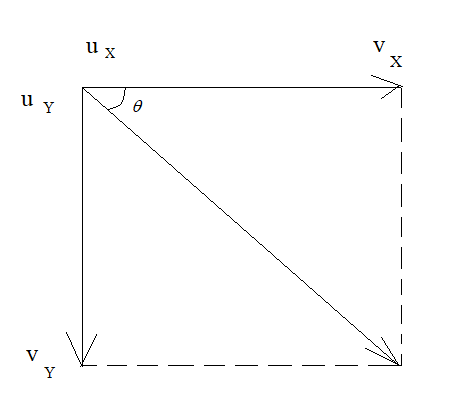Answer
425.1k+ views
Hint: Use the formula:
\[v = u + at\] and find the horizontal and vertical component of velocity.
Use the formula:
\[\tan \theta = \,\,\dfrac{{{v_Y}}}{{{v_X}}}\] to find the angle.
Complete step by step solution:
In this given problem, the plane is flying horizontally, whose velocity is \[100\,{\text{m}}{{\text{s}}^{ - 1}}\]. During the flight, it suddenly drops an object from it. The object does not fall horizontally, rather it will move at an inclination with the horizontal.
Let the angle at which the object falls to the ground be \[\theta \].

In the figure, the initial and the final velocity of the horizontal motion are indicated along with the initial and final velocity of the vertical motion.
\[{u_X}\] indicates the initial velocity along the horizontal motion.
\[{v_X}\] indicates the final velocity along the horizontal motion.
\[{u_Y}\] indicates the initial velocity along the vertical motion.
\[{v_Y}\] indicates the final velocity along the vertical motion.
Applying the formula, along the vertical component:
\[{u_X} = 100\,{\text{m}}{{\text{s}}^{ - 1}}\], \[{v_X} = ?\], \[{a_X} = 0\] and \[t = 10\,{\text{s}}\]
\[
{v_X} = {u_X} + {a_X}t \\
= 100 + 0 \times 10 \\
= 100\,{\text{m}}{{\text{s}}^{ - 1}} \\
\]
Applying the formula, along the horizontal component:
\[{u_Y} = 0\,{\text{m}}{{\text{s}}^{ - 1}}\], \[{v_X} = ?\], \[{a_X} = 10\,{\text{m}}{{\text{s}}^{ - 2}}\] and \[t = 10\,{\text{s}}\]
\[
{v_Y} = {u_Y} + {a_Y}t \\
= 0 + 10 \times 10 \\
= 100\,{\text{m}}{{\text{s}}^{ - 1}} \\
\]
The horizontal component of velocity is \[100\,{\text{m}}{{\text{s}}^{ - 1}}\] and the vertical component of velocity is \[100\,{\text{m}}{{\text{s}}^{ - 1}}\].
To find angle at which the object hits the ground:
Find tangent:
\[
\tan \theta = \,\,\dfrac{{{v_Y}}}{{{v_X}}} \\
\tan \theta = \,\,\dfrac{{100}}{{100}} \\
\tan \theta = \,\,1 \\
\theta = \,\,{\tan ^{ - 1}}\left( 1 \right) \\
\]
\[\theta = 45^\circ \]
The angle at which the object hits the ground is \[45^\circ \].
Note: In this problem, you are asked to find the angle at which the object hits the ground. For this, you have to take the vertical and the horizontal component separately. While calculating the horizontal component of velocity, take acceleration due to gravity as zero, as the gravitational pull does not act along the horizontal direction.
\[v = u + at\] and find the horizontal and vertical component of velocity.
Use the formula:
\[\tan \theta = \,\,\dfrac{{{v_Y}}}{{{v_X}}}\] to find the angle.
Complete step by step solution:
In this given problem, the plane is flying horizontally, whose velocity is \[100\,{\text{m}}{{\text{s}}^{ - 1}}\]. During the flight, it suddenly drops an object from it. The object does not fall horizontally, rather it will move at an inclination with the horizontal.
Let the angle at which the object falls to the ground be \[\theta \].

In the figure, the initial and the final velocity of the horizontal motion are indicated along with the initial and final velocity of the vertical motion.
\[{u_X}\] indicates the initial velocity along the horizontal motion.
\[{v_X}\] indicates the final velocity along the horizontal motion.
\[{u_Y}\] indicates the initial velocity along the vertical motion.
\[{v_Y}\] indicates the final velocity along the vertical motion.
Applying the formula, along the vertical component:
\[{u_X} = 100\,{\text{m}}{{\text{s}}^{ - 1}}\], \[{v_X} = ?\], \[{a_X} = 0\] and \[t = 10\,{\text{s}}\]
\[
{v_X} = {u_X} + {a_X}t \\
= 100 + 0 \times 10 \\
= 100\,{\text{m}}{{\text{s}}^{ - 1}} \\
\]
Applying the formula, along the horizontal component:
\[{u_Y} = 0\,{\text{m}}{{\text{s}}^{ - 1}}\], \[{v_X} = ?\], \[{a_X} = 10\,{\text{m}}{{\text{s}}^{ - 2}}\] and \[t = 10\,{\text{s}}\]
\[
{v_Y} = {u_Y} + {a_Y}t \\
= 0 + 10 \times 10 \\
= 100\,{\text{m}}{{\text{s}}^{ - 1}} \\
\]
The horizontal component of velocity is \[100\,{\text{m}}{{\text{s}}^{ - 1}}\] and the vertical component of velocity is \[100\,{\text{m}}{{\text{s}}^{ - 1}}\].
To find angle at which the object hits the ground:
Find tangent:
\[
\tan \theta = \,\,\dfrac{{{v_Y}}}{{{v_X}}} \\
\tan \theta = \,\,\dfrac{{100}}{{100}} \\
\tan \theta = \,\,1 \\
\theta = \,\,{\tan ^{ - 1}}\left( 1 \right) \\
\]
\[\theta = 45^\circ \]
The angle at which the object hits the ground is \[45^\circ \].
Note: In this problem, you are asked to find the angle at which the object hits the ground. For this, you have to take the vertical and the horizontal component separately. While calculating the horizontal component of velocity, take acceleration due to gravity as zero, as the gravitational pull does not act along the horizontal direction.
Recently Updated Pages
How many sigma and pi bonds are present in HCequiv class 11 chemistry CBSE

Why Are Noble Gases NonReactive class 11 chemistry CBSE

Let X and Y be the sets of all positive divisors of class 11 maths CBSE

Let x and y be 2 real numbers which satisfy the equations class 11 maths CBSE

Let x 4log 2sqrt 9k 1 + 7 and y dfrac132log 2sqrt5 class 11 maths CBSE

Let x22ax+b20 and x22bx+a20 be two equations Then the class 11 maths CBSE

Trending doubts
Fill the blanks with the suitable prepositions 1 The class 9 english CBSE

At which age domestication of animals started A Neolithic class 11 social science CBSE

Which are the Top 10 Largest Countries of the World?

Give 10 examples for herbs , shrubs , climbers , creepers

Difference between Prokaryotic cell and Eukaryotic class 11 biology CBSE

Difference Between Plant Cell and Animal Cell

Write a letter to the principal requesting him to grant class 10 english CBSE

Change the following sentences into negative and interrogative class 10 english CBSE

Fill in the blanks A 1 lakh ten thousand B 1 million class 9 maths CBSE



